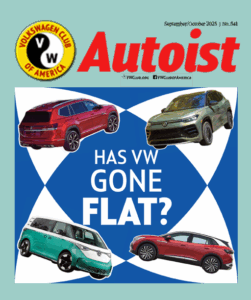 One look at VW’s 2025 U.S. sales reveals its slice of the American automotive pie is shrinking. Mazda, Subaru, Hyundai and Kia now outsell Volkswagen.
One look at VW’s 2025 U.S. sales reveals its slice of the American automotive pie is shrinking. Mazda, Subaru, Hyundai and Kia now outsell Volkswagen.
By Cliff Leppke
VW’s deliveries for the first half of 2025 were down 12.8% or 159,310 units. Look more closely and you’ll see sales tumbled during this year’s second quarter. Its EV sales slumped too. VW’s ID.4, for instance, is down 65% or 1,992 units. The EV’s best single-quarter figure was nearly 10,000 units in 2023.
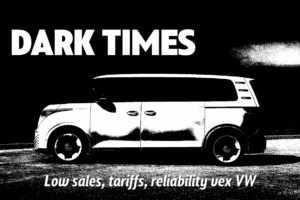 J.D. Power’s survey of purchasers and leasees of new vehicles, which incorporates repair visit data, indicates VW has yet another problem. Customers are frustrated with VW’s touchscreens, finding them overly complicated and too distracting. They, moreover, hate tapping and swiping through multiple menus to access vehicle functions. Power’s Initial Quality Study places Audi last among ranking brands at 269 problems per 100 vehicles. VW is three positions higher at 225. The study average was 192, and Lexus scored best with 166 problems per 100.
J.D. Power’s survey of purchasers and leasees of new vehicles, which incorporates repair visit data, indicates VW has yet another problem. Customers are frustrated with VW’s touchscreens, finding them overly complicated and too distracting. They, moreover, hate tapping and swiping through multiple menus to access vehicle functions. Power’s Initial Quality Study places Audi last among ranking brands at 269 problems per 100 vehicles. VW is three positions higher at 225. The study average was 192, and Lexus scored best with 166 problems per 100.
VW’s June 2025 EV registrations were 890, down 49% from last year. In contrast, Chevrolet climbed to 9,517 behind Tesla’s 57,260 during the same period. The maligned Cybertruck was down 53% to 2,184. Audi was 1,870 and Porsche 878. Ed Kim of AutoPacific says the hybrid powertrain option is drawing consumers away from full EVs. He says hybrids are “a much easier path to get greater efficiency for a whole lot of people.”
In May, overall EV sales declined 5.9% year over year, representing 7.1% of the U.S. light-vehicle market. Last year, EVs were 7.5% of sales. FYI: June EV registrations should increase slightly, as carmakers used incentives to reduce inventory before the federal EV tax credits expire in September.
VW’s halo vehicle, the ID. Buzz, might be the most cheerful looking people mover sold in the States, but its retail sales, which former VWoA CEO Pablo Di Si cautioned would be small, aren’t impressive. So VW now offers financing and customer cashback deals up to $2,500 off of the Buzz, and those who find a 2024 ID.4 can hack off $5,000 to $10,500.
Is the Buzz a mistake? 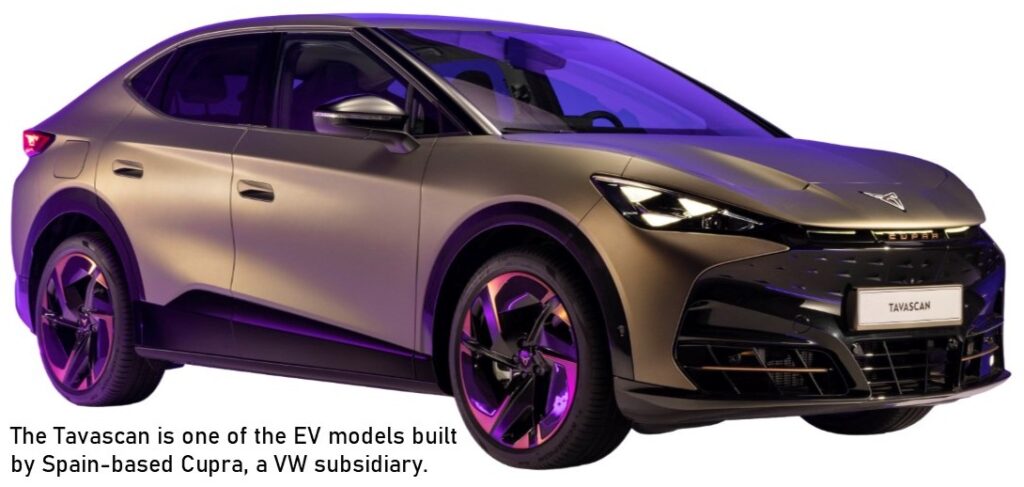
The Buzz looks destined to join other fanfare products, which despite favorable press and public interest, failed in the marketplace. One wonders whether this vehicle has a halo effect, drawing consumers to VW’s mainstream models. It looks like the Buzz might join the Phaeton and New Beetle as VW models that fizzled.
I don’t have VW’s insider knowledge of what’s behind the Buzz’s lack of buzz. Nevertheless, Richard Truett at Automotive News composed a letter recommending prompt corrections to save VW’s EV minivan. Truett’s proposal recommends immediate actions to stabilize short-term sales, such as a bigger battery pack. He follows this with a far more radical scheme: build it in the USA on the Scout’s chassis.
Truett has a point. Many say VW’s biggest goof was its ambitious EV plan. The company, after the diesel scandal, put all of its apples into one cart — the skateboard-like EV platform — which VW’s designer, Klaus Bischoff, thought was the right move. He told me it allowed him to develop EVs with different bodies draped over that skateboard. What he didn’t discuss is whether VW should have focused on range extenders or hybrids.
VWoA CEO Kjell Gruner says the brand plans to introduce only standard gasoline-electric hybrids in the U.S., arguing that the added cost and weight of plug-in hybrids make them unfeasible to sell in the country. On this latter point, my experience driving them confirms current plug-in hybrids are indeed heavier and less gas-fuel efficient in hybrid mode than their non-plug-in hybrid versions.
 The latter two vehicle propulsion types matter. Experts say hybrids are hot. Furthermore, Automotive News claims research, based on two different sources, shows would-be EV buyers are going hybrid rather than full EV. U.S. EV sales have flatlined, with Tesla and others reporting decreases. Nissan, Mercedes, Ford and Genesis have all announced either complete EV-plant shutdowns (Nissan), outright discontinuing EVs (Genesis G80) or delays in the introductions of new EV models (Ford’s next-gen electric pickup and van). Mercedes stopped or cut its U.S. EV production.
The latter two vehicle propulsion types matter. Experts say hybrids are hot. Furthermore, Automotive News claims research, based on two different sources, shows would-be EV buyers are going hybrid rather than full EV. U.S. EV sales have flatlined, with Tesla and others reporting decreases. Nissan, Mercedes, Ford and Genesis have all announced either complete EV-plant shutdowns (Nissan), outright discontinuing EVs (Genesis G80) or delays in the introductions of new EV models (Ford’s next-gen electric pickup and van). Mercedes stopped or cut its U.S. EV production.
VW slammed on the brakes too. It’s delaying the Cupra brand’s launch in the States past 2030. Cupra’s lineup has EVs and hybrids. In contrast, GM’s EV market share has grown. Tesla’s Cybertruck, however, reveals that the dominant EV maker, despite the model’s hype, can miss the mark.
Some of the EV discontent is tied to increased tariffs and the loss of the $7,500 federal tax credit. Market dynamics are complex. There are examples where carmakers stopped selling EVs in the USA but still offer them elsewhere. At VWAG, VW’s brand CEO Thomas Schäfer says the automaker plans to show an electric Golf based on what’s called the Scalable Systems Platform in 2029. It will be one of the first VWs to use Rivian’s electronics architecture.
 After an agreement in August between the Trump administration and the European Union, tariffs on European autos were expected to grow to 15% from the long-used 2.5%, meaning higher costs for the Buzz and Golf models.
After an agreement in August between the Trump administration and the European Union, tariffs on European autos were expected to grow to 15% from the long-used 2.5%, meaning higher costs for the Buzz and Golf models.
VW’s management has a defective crystal ball. It’s as if VW saw the future as static, missing the dynamic next-trend target. The company planned a full-turnaround in the States riding on the midsize American-made Passat. The car arrived too late and too timidly to become a solid choice in what became a dwindling market segment.
This year’s sales figures might be down for reasons unrelated to its EV plans. The 2025 Tiguan arrived midyear after its Mexican plant retooled to build a significantly upgraded SUV. Thus, those trading in their old Tiguans on the new one had to wait. Others say VW missed the compact SUV hotspot — a hybrid. VW’s management says hybrids are coming, possibly persuading its dealers to wait at least two more years for one to arrive. In contrast, I see the proposed higher output “Turbo” Tiguan as a possible smart move — the GTI of that segment.
Embarrassing stop-sale orders that affected ID.4 and ID. Buzz haven’t helped. The fixes are in and stop-sale orders lifted but Automotive News says VW’s EV retail sales haven’t rebounded. For those who remember when Scott Keogh introduced the 4, he predicted VW’s seminal EV would be for the millions, not millionaires. So far, while its deliveries are greater than VW’s GTI, it looks like neither the masses nor millionaires are lining up to buy it.
Then there’s what Automotive News calls the “holy war.” VW isn’t playing nicely with its dealers. VW, through the Alliance for Automotive Innovation, asked the U.S. Department of Justice to examine whether state franchise laws restrict competition and harm consumers. The Alliance specifically identified rules governing vehicle warranty service and limits on establishing dealerships.
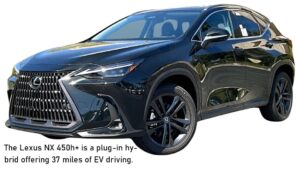 At VWoA, both of its sales/marketing pros (sales head Andrew Savvas and sales vice president Hein Schafer) quit. One dealer’s owner told me he wanted these guys to stick around after Di Si’s exit last year. Dealers build relationships with carmakers and want people who are focused on what dealers need. The “holy war,” if VW’s actions in Illinois or through the Alliance are any indication, stiffs its longtime partners — refusing to fully compensate dealers for warranty work or moving an entire EV line, the Scout, to a totally new distribution system, meaning VW dealers wouldn’t get this truck-style EV with a range-extending engine.
At VWoA, both of its sales/marketing pros (sales head Andrew Savvas and sales vice president Hein Schafer) quit. One dealer’s owner told me he wanted these guys to stick around after Di Si’s exit last year. Dealers build relationships with carmakers and want people who are focused on what dealers need. The “holy war,” if VW’s actions in Illinois or through the Alliance are any indication, stiffs its longtime partners — refusing to fully compensate dealers for warranty work or moving an entire EV line, the Scout, to a totally new distribution system, meaning VW dealers wouldn’t get this truck-style EV with a range-extending engine.
When one looks closely at the Buzz, experts say the product itself is partly the blame for its sales malaise. According to reporter Truett, the German-made Buzz needs a rescue. Only 2,465 were sold during the first half of the year. The vehicle is too expensive — something VW should have addressed from the get-go; it knew tariffs made imported vehicles more expensive. But the recently increased tariffs on imported European Union vehicles are new. With an EPA estimate of of 234 miles, range is problematic. Truett says a 300-mile range is the minimum acceptable in the U.S.
Then, there’s the vehicle’s interior. It’s playfully executed in contrasting colors and textures. But it’s largely a study in Legos — hard plastics, when a softer side with stitching and padded leatherette might fit the vehicle’s MSRP better. VW’s blasted touch interface is a sore spot. Truett says “all interior switchgear needs to be redesigned so that the controls are intuitive and easy to use.” He claims the ID. Buzz in its current form “isn’t viable.” He thinks the last thing VW needs is another Phaeton or New Beetle — vehicles that flatlined. But it might be the coolest VW failure since the Thing.
Vehicles of interest to VW drivers
Toyota’s 4Runner and Lexus’ NX 450h+ are examples of machines VW owners might find appealing. Both cater to segments of the “light” motor vehicle market where VW doesn’t play. The 4Runner, which has the as-seen-in National Graphic appeal — you’ll see Toyota trucks ranging from jungles and deserts to suburban driveways. I drive one as a workplace vehicle — used to cover severe weather events.
For 2025, the 4Runner comes in 12, that’s right a dozen, trims or submodels. I drove the TRD Off Road, which bucked, jiggled and pounded its way on Milwaukee’s admittedly awful streets. The vehicle’s hood, for example, shimmied like a hula doll. Thus, despite the machine riding on Toyota’s new truck platform, the one I drove wasn’t an ideal urban runabout.
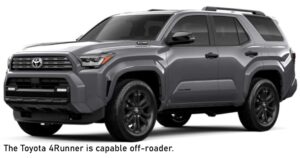 The off-road gizmos (crawl control and sway-bar disconnect) and simple twist-a-dial selection of 2WD, 4WD or 4WD Low make off-roading a snap. Some items such as the shifter and some knobs felt flimsy.
The off-road gizmos (crawl control and sway-bar disconnect) and simple twist-a-dial selection of 2WD, 4WD or 4WD Low make off-roading a snap. Some items such as the shifter and some knobs felt flimsy.
The Lexus NX rides on the Toyota RAV4’s setup. The 450h+ I drove is the plug-in hybrid version. If you plug it in, say, every day, you might EV it for 37 miles never knowing that when the engine kicks in, it’s a noisy beast. Also its EV range lost about three miles during my highway trek.
I found I could drive to work and back — about 16 miles round trip — thinking the NX was slick, quick and more comfortable than a RAV. The interior has much more padding, and EV driving means no engine rumble.
But there’s a thorn in this vehicle’s setup. Its default driving mode is EV. When you floor the go pedal all you get is the electric motor’s horses. The gas-fed ones wait until the EV’s battery is depleted. This is wrong. You can press a button to change this hierarchy.
Nonetheless, Lexus should let you pick whether you want to restrict its accelerative abilities. Hybrid, not EV, should be the default. ![]()
Cliff Leppke | leppke.cliff@gmail.com
ALSO IN THIS ISSUE:
* BUYING THE FARM: North Dakota property’s array of cars, parts, tools and more are dispersed.
* BURNISHED ANTIQUES: Old Beetles continue to creep to a milestone status.
* RECALLING VW’S XL1 CONCEPT: The slick two-seater with gullwing doors duels with VW’s contemporary ID.7 EV.
* CONSIDERING AN OVAL WINDOW?: The pricey old Beetles are few in numbers. Hagerty’s Evaluation Tool offers help.
PLUS OUR REGULAR COLUMNS AND FEATURES:
* Small Talk – VW + Audi at a glance
* Retro Autoist – From the VWCA archives
* The Frontdriver – Richard Van Treuren
* ID Insight – Todd Allcock
* Beetle World – Steve Midlock
* Editor’s Turn – Fred Ortlip
* Local Volks – Activities of VWCA affiliates
* Classified – . . . Ads from members and others
* Parting Shot – Photo feature
